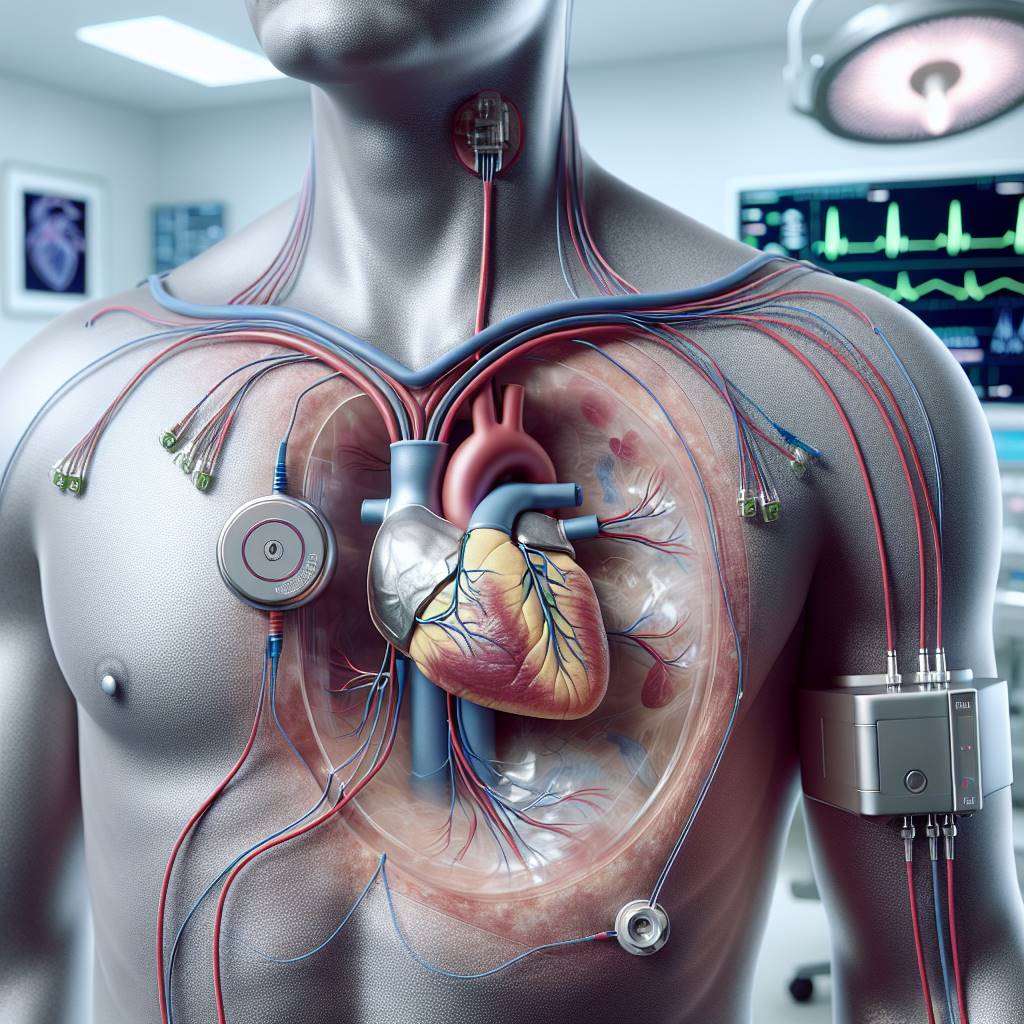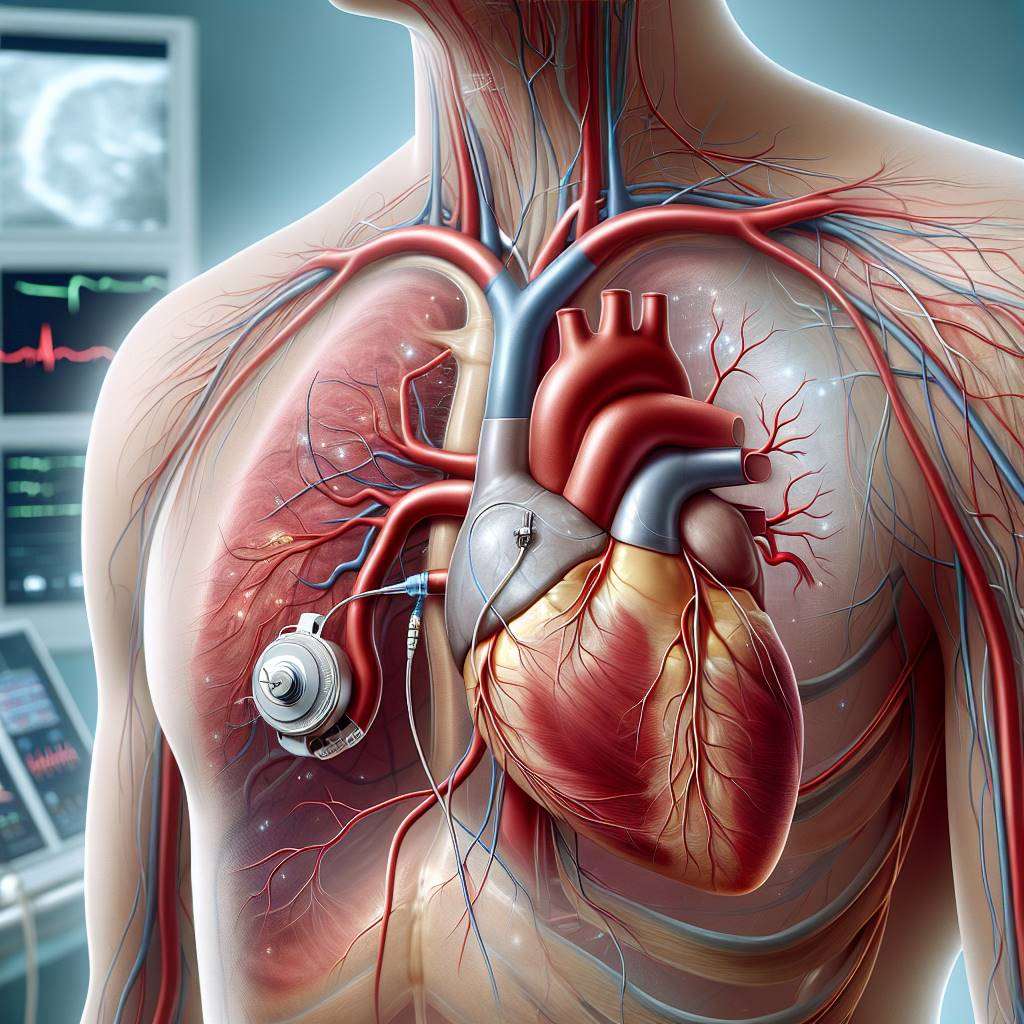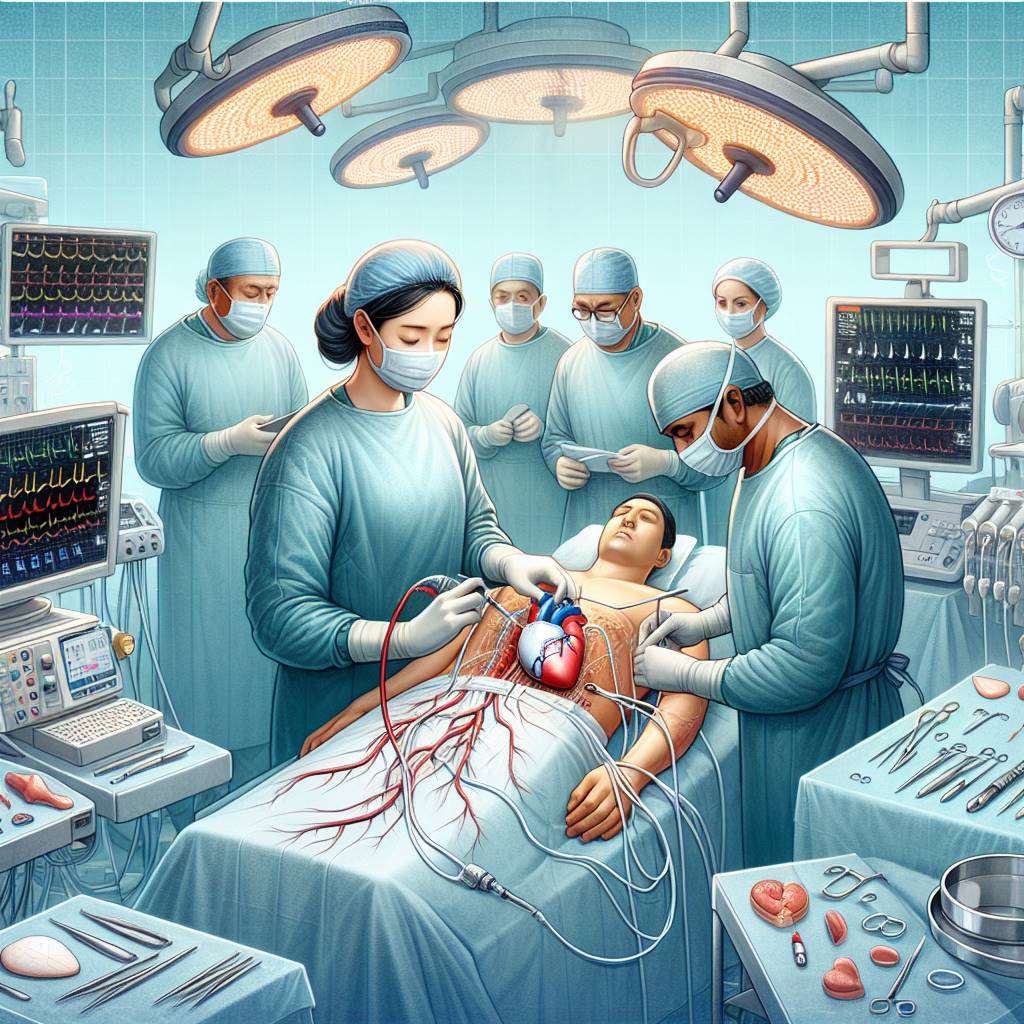Implantable Cardioverter Defibrillators (AICDs) are life-saving devices used to manage severe heart rhythm disorders. While commonly associated with older adults, their use in younger patients, including teens and adults under 40, is growing. This trend highlights the need for awareness about their benefits and risks in this age group.
For younger individuals with conditions like ventricular arrhythmias or a family history of sudden cardiac arrest, an AICD can provide critical protection. Understanding the implantation process, potential complications, and long-term outcomes is essential for patients and caregivers to make informed decisions about this advanced treatment option.
What Is an AICD and How Does It Work?
An Implantable Cardioverter Defibrillator (AICD) is a small electronic device placed under the skin to monitor and regulate abnormal heart rhythms. It is primarily used to treat life-threatening arrhythmias such as ventricular tachycardia and ventricular fibrillation. The device delivers electrical shocks to restore a normal heart rhythm when it detects irregularities.
The AICD consists of a pulse generator and leads. The generator houses the battery and circuitry, while the leads are wires that connect the device to the heart. These leads detect abnormal rhythms and deliver therapy as needed. AICDs are particularly beneficial for patients at high risk of sudden cardiac arrest due to genetic conditions like Long QT Syndrome or structural heart diseases.
This advanced technology has revolutionized cardiac care, offering a reliable safety net for individuals with severe heart conditions. Its ability to continuously monitor and respond to heart activity makes it a critical tool in modern cardiology.

Signs You May Need an AICD Before Age 40
Younger patients may require an AICD if they have specific heart conditions or symptoms that increase their risk of sudden cardiac arrest. Common indicators include a history of fainting, palpitations, or episodes of ventricular arrhythmias. Additionally, individuals with a family history of sudden cardiac death or genetic disorders like Hypertrophic Cardiomyopathy may benefit from this device.
Some key signs to watch for include:
- Unexplained fainting or dizziness, especially during physical activity.
- Documented episodes of abnormal heart rhythms.
- History of cardiac arrest or near-fatal arrhythmias.
- Presence of inherited heart conditions like Brugada Syndrome.
Early diagnosis and intervention are crucial for younger patients. If you or a loved one experience these symptoms, consult a cardiologist to evaluate the need for an AICD. Timely implantation can significantly reduce the risk of life-threatening events.
Understanding Implantation Procedures for Younger Patients
The AICD implantation procedure is a minimally invasive surgery performed under local anesthesia or mild sedation. For younger patients, the process is tailored to minimize risks and ensure long-term device functionality. The procedure typically involves placing the device under the skin, usually near the collarbone, and connecting leads to the heart.
Pre-surgical evaluations, including imaging and electrophysiological studies, help determine the optimal placement of the device. The surgery usually lasts 1–2 hours, and most patients can return home within a day. Post-implantation, regular follow-ups are essential to monitor the device and ensure it is functioning correctly.
Advances in technology have made AICDs smaller and more efficient, reducing discomfort and improving outcomes for younger patients. Understanding the procedure and recovery process can help alleviate concerns and prepare patients for a smoother experience.
Benefits of AICD Use in Teens and Young Adults
The use of AICDs in teens and young adults offers numerous benefits, particularly for those at high risk of sudden cardiac arrest. These devices provide continuous monitoring and immediate intervention, significantly improving survival rates. For younger patients, an AICD can offer peace of mind and enable them to lead more active lives.
Key benefits include:
- Reduced risk of sudden cardiac death.
- Improved quality of life with fewer restrictions on physical activity.
- Long-term protection for genetic or structural heart conditions.
- Enhanced ability to detect and treat arrhythmias promptly.
By providing a reliable safety net, AICDs empower younger patients to manage their heart conditions effectively. This life-saving technology has transformed the outlook for individuals with severe cardiac risks, allowing them to focus on their personal and professional goals.
Risks and Complications of AICD in Younger Patients
While AICDs are highly effective, they are not without risks. Younger patients may face unique challenges, including device-related complications and psychological impacts. Common risks include infection at the implantation site, lead displacement, and inappropriate shocks due to device malfunction or sensitivity.
Long-term use of an AICD may also require periodic replacements, which can increase the risk of complications. Additionally, younger patients may experience anxiety or stress related to living with a medical device. It is crucial to address these concerns through counseling and support groups.
A comparison of potential risks and benefits can help patients and caregivers make informed decisions:
| Potential Risks |
Benefits |
| Infection, lead issues, or device malfunction. |
Reduced risk of sudden cardiac death. |
| Need for periodic replacements. |
Improved quality of life and activity levels. |
| Psychological impact of living with a device. |
Immediate intervention for life-threatening arrhythmias. |
Open communication with healthcare providers can help mitigate risks and ensure the best outcomes for younger patients with AICDs.
How AICD Helps Prevent Sudden Cardiac Arrest
An Automatic Implantable Cardioverter Defibrillator (AICD) is a life-saving device designed to monitor and regulate abnormal heart rhythms. It is particularly effective in preventing sudden cardiac arrest (SCA), a condition where the heart suddenly stops beating due to irregular electrical activity. For younger patients, this device can be a critical intervention, especially for those with genetic heart conditions like hypertrophic cardiomyopathy or long QT syndrome.
The AICD continuously monitors the heart's rhythm and delivers an electrical shock if it detects a life-threatening arrhythmia. This immediate response can restore a normal heartbeat and prevent fatal outcomes. By offering real-time protection, the AICD provides peace of mind to patients and their families, ensuring that they are safeguarded against unpredictable cardiac events.

Who Qualifies for AICD Implantation Under 40?
Not everyone under 40 is a candidate for an AICD implantation. This device is typically recommended for individuals with a high risk of ventricular arrhythmias or sudden cardiac arrest. Patients with a family history of genetic heart disorders, such as Brugada syndrome or arrhythmogenic right ventricular dysplasia, are often evaluated for AICD suitability.
Other qualifying factors include a history of fainting episodes, prior cardiac arrest, or weakened heart muscles due to conditions like dilated cardiomyopathy. Doctors also assess the patient's overall health, lifestyle, and potential risks before recommending the procedure. Early diagnosis and consultation with a cardiologist are crucial to determine if an AICD is the right choice for younger patients.
Recovery Timeline After AICD Implantation Surgery
Recovery after an AICD implantation typically takes a few weeks, but the exact timeline can vary depending on the patient's age, health, and lifestyle. Most patients are discharged within 24–48 hours after the procedure. During the first week, mild discomfort or swelling at the implantation site is common, but this usually resolves with proper care.
Here’s a general recovery timeline:
- First week: Avoid strenuous activities and keep the incision site clean and dry.
- 2–4 weeks: Gradually resume light activities but avoid heavy lifting or overhead arm movements.
- After 4 weeks: Most patients can return to normal routines, including work and exercise, with their doctor’s approval.
Regular follow-ups with a cardiologist are essential to ensure the device is functioning correctly and to monitor the patient’s overall health.
Living with an AICD: Tips for Younger Patients
Adjusting to life with an AICD can be challenging for younger patients, but with the right guidance, they can lead a fulfilling life. It’s important to follow a heart-healthy lifestyle, including a balanced diet, regular exercise, and avoiding smoking or excessive alcohol consumption.
Here are some tips for managing life with an AICD:
- Carry an AICD identification card at all times for emergencies.
- Avoid prolonged exposure to strong electromagnetic fields, such as those from MRI machines or industrial equipment.
- Attend regular check-ups to ensure the device is functioning optimally.
- Join support groups to connect with others who have similar experiences.
By staying informed and proactive, younger patients can minimize complications and enjoy a high quality of life with their AICD.
How Safe Is AICD for Teenagers and Young Adults?
The safety of AICD implantation in teenagers and young adults has been well-documented. Advances in medical technology have made the procedure minimally invasive, with a low risk of complications. For younger patients, the benefits of preventing sudden cardiac arrest far outweigh the potential risks.
Common concerns include infection at the implantation site, device malfunction, or inappropriate shocks. However, these risks are rare and can be minimized with proper surgical techniques and regular follow-ups. Studies have shown that AICDs significantly improve survival rates in high-risk patients, making them a reliable option for managing life-threatening arrhythmias.
Parents and young patients should discuss all concerns with their cardiologist to understand the procedure, its benefits, and any potential risks. With proper care, AICDs are a safe and effective solution for younger individuals at risk of cardiac events.
Cost of AICD Implantation in India: What to Expect
The cost of an Automatic Implantable Cardioverter Defibrillator (AICD) implantation in India varies based on factors like hospital type, device brand, and patient-specific needs. On average, the procedure can range from ₹5,00,000 to ₹10,00,000, depending on the complexity.
Government hospitals may offer subsidized rates, while private hospitals often charge more due to advanced facilities. Patients should also consider additional costs like pre-surgery tests, post-operative care, and follow-up consultations. Insurance coverage is crucial, and many policies now include AICD implantation under cardiac care.

Latest Advances in AICD Technology for Young Patients
Recent advancements in AICD technology have made devices smaller, more efficient, and tailored for younger patients. Modern AICDs now feature wireless monitoring, which allows doctors to track heart rhythms remotely, reducing the need for frequent hospital visits.
Additionally, newer models are designed to minimize unnecessary shocks, improving the quality of life for patients. These devices are also MRI-compatible, a significant improvement for young individuals who may require imaging in the future. Battery life has been extended, reducing the need for frequent replacements.
These innovations ensure that younger patients can lead active lives while managing their cardiac conditions effectively. Discussing these options with a cardiologist can help identify the best device for individual needs.
When Should Teens Consider an AICD Implant?
Teens may require an AICD implant if they have a high risk of sudden cardiac arrest due to conditions like hypertrophic cardiomyopathy, long QT syndrome, or arrhythmias. Early diagnosis and intervention are critical in preventing life-threatening events.
Signs that may indicate the need for an AICD include fainting episodes, a family history of sudden cardiac death, or abnormal heart rhythms detected during routine check-ups. A thorough evaluation, including ECG, echocardiogram, and genetic testing, helps determine the necessity of the device.
- Unexplained fainting or seizures
- Family history of cardiac arrest
- Diagnosed heart rhythm disorders
Parents and teens should consult a pediatric cardiologist to understand the benefits and risks of implantation.
Managing Lifestyle Changes After AICD Implantation
After an AICD implantation, young patients need to adapt to certain lifestyle changes to ensure the device functions optimally. Physical activity is encouraged, but contact sports or activities with a high risk of trauma should be avoided to protect the device.
Patients should also avoid strong electromagnetic fields, such as those from MRI machines (unless the device is MRI-compatible) or industrial equipment. Regular follow-ups with a cardiologist are essential to monitor the device and overall heart health.
Psychological support is equally important, as adjusting to life with an AICD can be challenging. Support groups and counseling can help patients and their families navigate these changes effectively.
Long-Term Outcomes of AICD Use in Young Adults
The long-term outcomes of AICD use in young adults are generally positive, with the device significantly reducing the risk of sudden cardiac death. Studies show that patients with AICDs can lead fulfilling lives with proper care and regular monitoring.
However, there are potential challenges, such as device-related complications or the need for replacements due to battery depletion. Emotional well-being is another critical aspect, as living with a medical device can sometimes cause anxiety or stress.
| Benefits |
Challenges |
| Prevents sudden cardiac arrest |
Risk of device malfunction |
| Improves survival rates |
Regular follow-ups required |
With advancements in technology and comprehensive care, young adults with AICDs can achieve excellent long-term outcomes.
Best Aicd Implantation Doctors in India
Dr. Balbir Singh, a renowned cardiologist with over 30 years of experience, is affiliated with Medanta - The Medicity, Gurugram. He holds an MD, DM, and has extensive expertise in electrophysiology and device implantation. Another expert is Dr. Praveen Chandra, Chairman of Interventional Cardiology at Medanta - The Medicity, Gurugram, with over 25 years of experience in advanced cardiac care. Learn more on best aicd implantation doctors in india.
Best Aicd Implantation Hospitals in India
Fortis Escorts Heart Institute, New Delhi, a NABH and JCI-accredited hospital, is a leader in cardiac care with advanced electrophysiology labs and international patient services. Medanta - The Medicity, Gurugram, also NABH and JCI-accredited, offers cutting-edge device implantation and robotic cardiac surgery. Both hospitals are known for multidisciplinary care and high success rates. Find more best aicd implantation hospitals in india.
Aicd Implantation Cost in India
The cost of AICD implantation in India typically ranges from INR 5,00,000 to INR 10,00,000 (approximately USD 6,000 to USD 12,000). Factors such as the doctor’s expertise, hospital accreditation, and device type influence the cost. The average hospital stay is 2-3 days. India offers a significant cost advantage compared to Western countries, with medical insurance and financing options available. Learn aicd implantation cost in india.
Aicd Implantation Treatment in India
AICD implantation in India involves placing the device under the skin near the chest, with leads connected to the heart. The procedure is performed under local anesthesia and guided by advanced imaging techniques. Recovery typically takes 1-2 weeks. Top hospitals in India use innovations like 3D mapping and adhere to global medical protocols, ensuring high success rates. Learn on Aicd Implantation Treatment in India.
FAQs
What is an AICD?
An AICD (Automatic Implantable Cardioverter Defibrillator) is a device implanted in patients at risk of life-threatening arrhythmias. It monitors heart rhythms and delivers shocks to restore normal rhythm if needed.
Who needs an AICD?
Patients with conditions like ventricular tachycardia, ventricular fibrillation, or a history of sudden cardiac arrest may require an AICD to prevent future episodes.
Is AICD implantation safe for younger patients?
Yes, AICD implantation is safe for younger patients. It is a minimally invasive procedure with a low risk of complications when performed by experienced specialists.
How long does an AICD last?
The battery life of an AICD typically ranges from 5 to 10 years, depending on usage. Regular follow-ups are essential to monitor its performance.
What are the risks of AICD implantation?
Risks include infection, bleeding, or device malfunction. However, these are rare when the procedure is performed in a well-equipped hospital by experienced doctors.
Can I lead a normal life with an AICD?
Yes, most patients with an AICD can lead a normal life. However, certain precautions, such as avoiding strong electromagnetic fields, are necessary.
How soon can I return to daily activities after AICD implantation?
Most patients can resume light activities within a week and normal activities within 4-6 weeks, depending on their doctor’s advice.
Is AICD implantation covered by insurance in India?
Yes, many health insurance plans in India cover AICD implantation. It is advisable to confirm coverage details with your insurance provider.
What follow-up care is required after AICD implantation?
Regular follow-ups are needed to check the device’s function and battery life. Remote monitoring may also be available in some cases.
Are there alternatives to AICD implantation?
In some cases, medications or other devices like pacemakers may be considered, but an AICD is the most effective option for preventing sudden cardiac death in high-risk patients.
Understanding AICD: Importance of Check-Ups and Survival Benefits
An Automated Implantable Cardioverter Defibrillator (AICD) is a crucial device for patients at risk of life-threatening arrhythmias. Regular check-ups are essential to ensure the device is functioning correctly and to monitor the patient's heart health. If you're curious about what happens during an AICD check-up, you can explore the detailed process in our blog post on AICD check-ups.
For heart failure patients, the AICD can significantly improve survival rates by providing timely interventions during critical moments. Understanding how this device enhances patient outcomes is vital for those considering it as part of their treatment plan. Learn more about the survival benefits of AICD for heart failure patients in our informative article on AICD and heart failure.
Incorporating regular follow-ups and understanding the life-saving potential of AICD can empower patients to take charge of their heart health effectively.